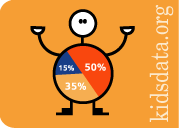The
California Index of Child and Youth Well-Being
..................................................................................................................................................................................................................
What Is the California Index of Child Well-Being?
|
||||||||||||||
An index of child well-being is a summary measure of the status of children that provides insight into how child well-being has evolved over time. The index is constructed by aggregating results from a set of specific indicators of children's status. For decades, indices have been instrumental in monitoring economic trends (e.g., the Dow Jones Average, the Consumer Price Index). More recently, indices that measure quality of life have been developed, including by Duke professor Kenneth Land and associates, who created the national Child Youth and Well-Being Index (CWI) to track changes in some 28 indicators in the quality of life for U.S. children.
The California Index of Child and Youth Well-Being applies the national CWI to California, in order to assess how children overall in California -- as well as in specific demographic groups and regions -- have been faring.
Methodology: A Brief Overview
A full description of the methodology is available, but briefly, the construction of this index began with a review of more than 250 child and youth-related indicators available through kidsdata.org. From that group, 16 key indicators were chosen because of their consistency with the national Child Well-Being Index and because enough data points were available in the designated time period for each indicator to conduct a thorough analysis. While 16 indicators don’t capture all aspects of child well-being, when grouped together as an index, these indicators generally track with the more robust 28-indicator national CWI, which is supported by rigorous research, and has been published in a peer-reviewed journal.
The year 1995 was set as the as the target base year for this benchmarking study with the goal of tracking trends for more than a decade, until 2006, the most current year for which the majority of data were available for the 16 indicators.
Each key indicator then was assigned to one of five domains of child and youth well-being:
- Family Economic Well-Being
- Health
- Safety/Behavioral Concerns
- Educational Attainment
- Emotional Well-Being
These domains – or similar domains with different names – have been well-established in numerous well-being studies over the past three decades.
To calculate the overall score, each of the 16 indicators was indexed in reference to the base year (1995). The base year for that indicator was assigned a value of 100 and subsequent values were taken as percentage changes in the index from the base year. The directions of the indicators were oriented so that a value greater than 100 meant that the social condition improved and a value of less than 100 indicated the condition has deteriorated.
These 16 indicators were then grouped into the five domains of well-being, and each domain was assigned a value. Then, the five domain-specific indices were aggregated into an equally weighted composite index for each year.
The demographic indices are computed following the same procedures as the overall index. Composite indices are calculated separately for the four racial/ethnic groups examined in this study: African American, Asian, Latino, and Caucasian.
For a detailed overview of the methodology, including information about the methodology for the poverty projections and the racial/ethnic disparity indices, view the full report's methodology section.

